adriaticnature starts the “Brand” column by getting acquainted with Russkaya Blesna Company, which was deservedly recognized as one of the fastest developing Russian companies engaged in producing metal lures for catching sea and freshwater fish.
Russkaya Blesna Company was founded in 2006 in Moscow, Russia.
RB lures were highly praised at European exhibitions, including TTW in Amsterdam, T&G Show in Great Britain, ANSPO in Germany, Spring fishing & boat show in Canada. In particular, RB is the winner of EFFTEX-2009 international exhibition in the nomination of “The Best Metal Lure” and the runner-up of EFFTEX-2011 in the same nomination.
adriaticnature called the founder, ideological chief of the company, and professional fisherman Gleb Gorsky to find out information about the unique features of RB lures.
– Hello, Gleb! Thanks for getting around to our conversation. Tell me, please, nowadays one can find a large number of metal fishing lures in the market, including jigs, spinners, and spoons. Not to mention the enormous amount of products offered by Chinese manufacturers, for example, the Aliexpress trading platform. And you increase and improve your range annually. Tell us, please, about the way you cope with the competition and the peculiarities of Russkaya Blesna products. What distinguishes them from other lures presented in the fishing market?

(Gleb Gorsky. Catching the surf smelt on the ice near Sakhalin. Photo by © Russkaya Blesna)
– Good afternoon! It’s no secret that nowadays the business of many world companies is based on the production of fishing lures in China. And the business of the overwhelming majority of Chinese companies, as in the case of aliexpress, for instance, looks like this: CEO of Chinese manufacturing company saw that metal lures, designed by some famous or not very famous fishing manufacturer, were popular with customers. Or CEO of Chinese company thought that those lures were popular.
In most cases, Chinese metal lures are stamped. This production method is cheap and simple, that’s why spoons are produced in China very extensively. They copy the shape of the lure, take a sheet of metal 2 millimeters thick, for example. And stamping begins. Here comes the first blow of the tool – and the shape is cut out, the second blow – and there is the required bend. And in 99% of cases, it is done without testing them in water bodies, and moreover, without understanding the purposes of the lures. One thing is certainly true: the manufacturer who produced this “stuff” guesses that this product is related to fishing, one way or another.

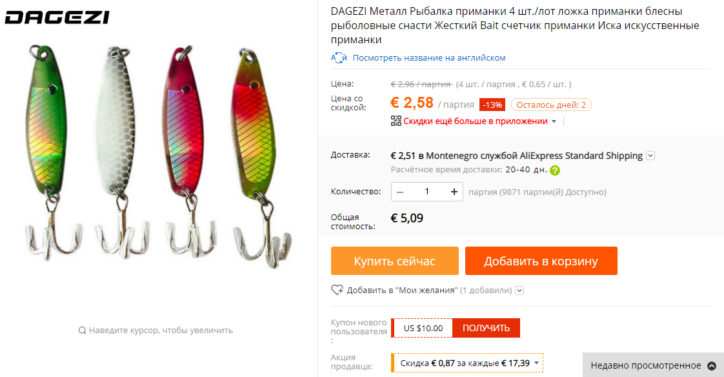
(Screenshot from aliexpress.com)
By the way, I visited exhibitions in China and saw copies of RB lures at the stands, among other things.
The main approach of Chinese manufacturers is to involve potential customers in the purchase of a large number of cheap products. Besides, they often follow the “third rate is not a flaw” principle. Suppose the run of lures is 5,000 copies. After that, they are painted. Sometimes it’s better, and sometimes it’s worse. Suppose the first thousand lures is painted blue, the second one is red, the third one is purple, the fourth one is green, and the fifth one is gray. Then the wholesale buyer takes the ordered products, the seller gives the minimum run, that is, 5 thousand copies of various colors.
Afterwards, in theory, the commercial success of the wholesale buyer’s actions occurs. The lures are being sold quickly (if things shape up in favor), marginal revenue is high, the seller, who has been the buyer recently, is endlessly happy. But it takes a little time and it becomes clear that, for example, red and green lures are in demand, but violet, black and blue are not so popular. As a result, the seller sold a thousand red and a thousand green lures. But three thousand lures are wasted. Then, they are being sold at half price, or even less, for years. Such a project ends with a minimum profit at its best, but more often it either breaks even or is lossmaking.
Such a “business” is a nightmare for us. I think that our product is unique: Russkaya Blesna is one of a few companies that arranged the production of fishing products in Russia. Not a single lure of our brand is produced in China or any other country.
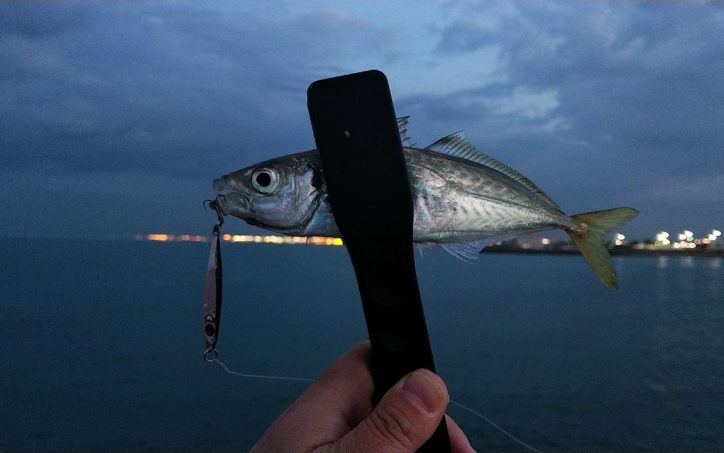
(RB “Roxi” jig and horse mackerel. Photo by © Russkaya Blesna)
Over the past decade, we have developed several hundred models of fishing lures. However, we keep a small number of our products in stock. This is due to the fact that we are able to produce the necessary amount of lures of the right color for the customer within a week or two. Moreover, our product range is constantly expanding. This is our major approach: we develop fishing lures for fishermen of specific regions for the implementation of specific fishing tasks. Production of RB lures is a laborious and even an exquisite process if you say so. And it doesn’t begin with the production itself. But we’ll talk about it later.
RB uses casting technology for investment patterns in production. At first, a 3D model of a lure is drawn with the help of graphic computer programs. Then, a bar is cut out using a high-precision milling machine. Experienced fishermen are involved in testing future lures. The bar is licked into shape until it can perform its functions consistently and qualitatively. If the results of the amendments are even a little less than satisfactory and, eventually, the bar moves in water inappropriately – the model is rejected. If the result is satisfactory – we proceed to the process of manufacturing the matrix.
A rubber mold for making wax copies is produced using a metal matrix and vulcanization method. Then, the rubber mold is cut into two parts and a molding channel is inserted into it. Jewelry wax is poured into the rubber mold under pressure in order to get a wax copy. And this happens several dozen times.
After that, these wax copies of future products are soldered to the wax rod manually using molding channels. At this stage of production, this product looks like a wax fir tree with wax molding channels instead of branches and cones instead of wax jigs, for example.


(Wax “fir trees”. Photo by © Russkaya Blesna)
The “fir tree” is covered with gypsum and moved to the vibrating table. Then, it is placed into the muffle furnace for 18 hours – the gypsum freezes, and the wax burns away ashless. This gypsum model is put into an injection-molding machine where the molten metal is poured under pressure and at a temperature of about 900 degrees Celsius using a special injection-molding machine produced in Germany. The gypsum model is washed with water and the “fir tree” is obtained again, but this time it is made of metal. This production stage is completed after metal molding channels are removed from the future lures.


(“Fir trees” cast in metal. Photo by © Russkaya Blesna)
After that, the stage of tooling parts, surface cleaning and preconditioning, that is, rumbling, begins. The product is cleaned of oxides in advance. The rumbling process goes through several stages in the polishing machine: the product gets mirror smooth finish due to the usage of special ceramic grains of different dispersity, then, it is polished with a nutshell grit of different dispersity. After the final manual polishing, which is sometimes necessary, the product is sent to the electroplating shop, where the future lure is covered with several layers of electroplated coating. Most often, galvanic silver 12 microns thick is used as a final coating. Its color attracts predatory fish.
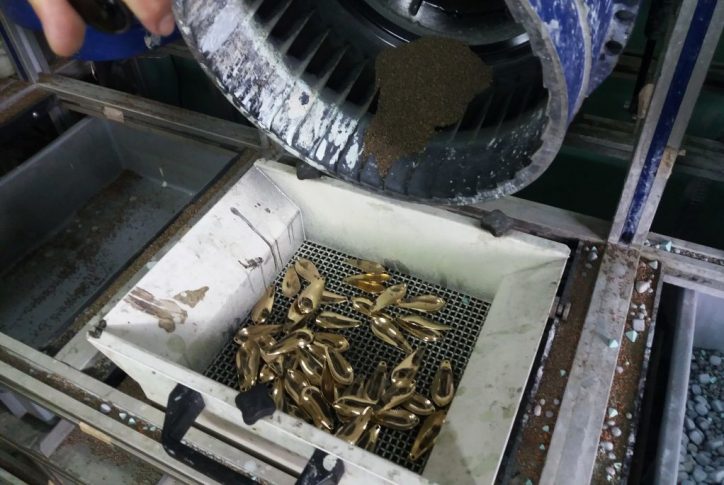
(One of the stages of lure polishing. Photo by © Russkaya Blesna)
Quite often, the process isn’t finished at electroplated coating and, if required, the lures are painted in different colors or a holographic coating is implemented to the product. Then, the lure is varnished in several layers.
Russkaya Blesna makes “exclusive” lures. They are intended for the fish species, depicted on them. This adds aesthetics to the fishing process. Besides, presenting them to fellow fishermen is always a pleasure.
Here is the non-exhaustive list of possible options and possibilities used by RB in production: copper plating, blackening, gold plating, silver-plating, and their combination.
All these processes push up the cost of production. But the obtained product of the highest level quality is the result of such complex technological processes!
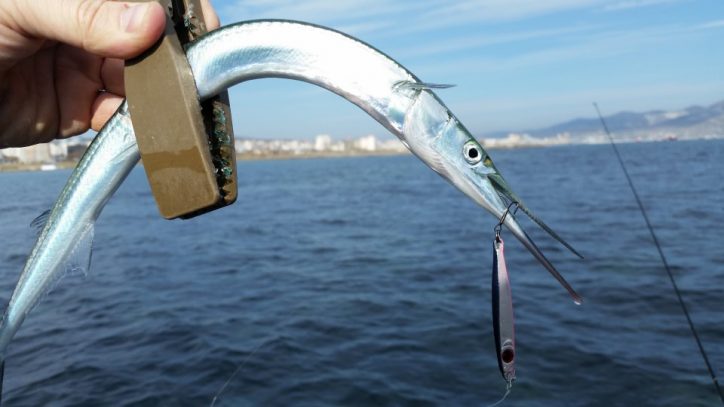
(RB “Roxi” jig and garfish. Photo by © Russkaya Blesna)
Once again, let’s consider the small percentage of our Chinese fellows who are still engaged in casting, rather than stamping lures. They usually use a ZAMAK alloy, a family of zinc alloys doped with aluminum, magnesium, and copper, with a density of about 5 grams/cm³. It is clear that the lures of the same shape and made from alloys of different density will be different in weight and, consequently, they will move in a completely different way in the water. That’s why, we use heavier alloys and metals, such as brass, with a density of 8 g/cm³ in our production.
RB also uses leads to producing some products as well.
The years-long practice of producing metal lures has provided us with invaluable experience in “lure construction”.
RB is a limited piece of production. We produce up to 100 copies of lures in one production run. Besides, we can take orders in the same minimum amount for the production of one model. And we can even suggest different painting options of these models at the request of the customer.
Essentially, RB uses “handmade” technologies for producing lures.
A little earlier I said that our product doesn’t start with lure production. We begin with understanding what our customer needs. We always follow the feedback principle. RB is client-oriented. This is a peculiar feature of our company.
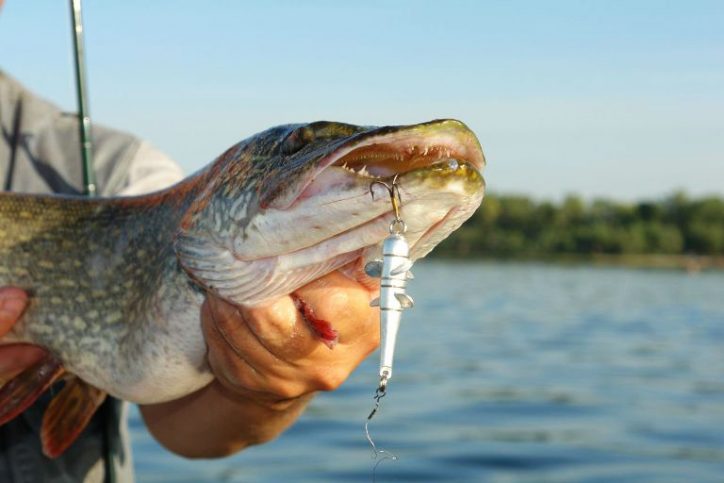
(RB “Osa” devon lure and pike. Photo by © Russkaya Blesna)
We have a clear region-wise differentiation of lures. We always respond to comments, suggestions, and ideas of fishermen using the RB products. We strive to make the lures that satisfy our customers to the fullest. And, of course, we produce the lures preferred by the fish species of different regions. We will surely never supply Poland with the lures that are in demand and originally designed for fishing in Kamchatka.
As for sea lures, a special approach was used while developing them. We have worked with a biologist, who knows the habits of fish perfectly, for a long time. He has traveled all the seas and continents. At the same time, he has been a fan of fishing for more than half a century. The models were tested under experimental conditions and on the sea after that. They get things done perfectly.
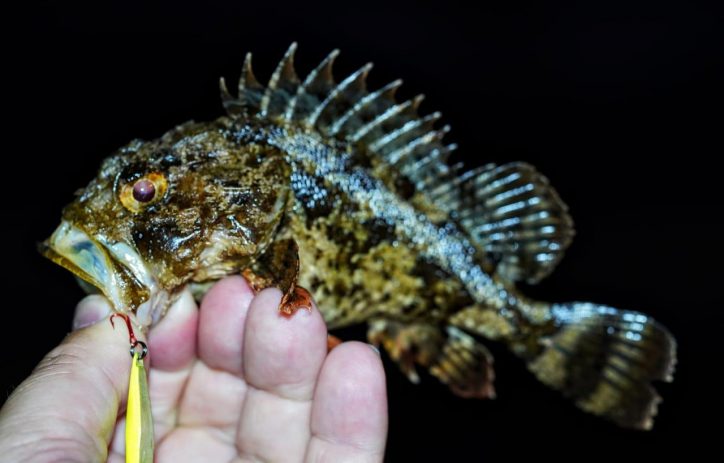
(RB “Roxi” jig and black scorpionfish. Photo by © Russkaya Blesna)
RB is a sponsor of fishing competitions, including sea fishing. 5-6 years ago we sponsored the Salty Rocks Championship, held in Anapa on the Black Sea. We’ve sponsored the autumn Novorossiysky Sargan Tournament recently. We provide the participants with our sea lures at these events, they test the baits. The number of participants is often more than a hundred people. Video tests and competitions can be found on the Internet.

(Annular seabream at the Novorossiysk Sargan tournament and RB “Roxi” jig. Photo by © Russkaya Blesna)
Russkaya Blesna Company produces a great number of lures, and the format of our conversation doesn’t let me talk about every lure in detail, but I’ll try to highlight the lures, the use of which while fishing on the Adriatic Sea and freshwater bodies of the countries located on the Adriatic will provide excellent results.
RB poses the development of the sea program of metal lures as an important and priority direction.
The model range of RB jigs, which is more often referred to as “metal jig” in the international market, is currently represented by 10 models. Their forms are original and thoroughly thought over. As I’ve already mentioned, professional biologists worked on their development, and they were successfully tested “in combat conditions”.
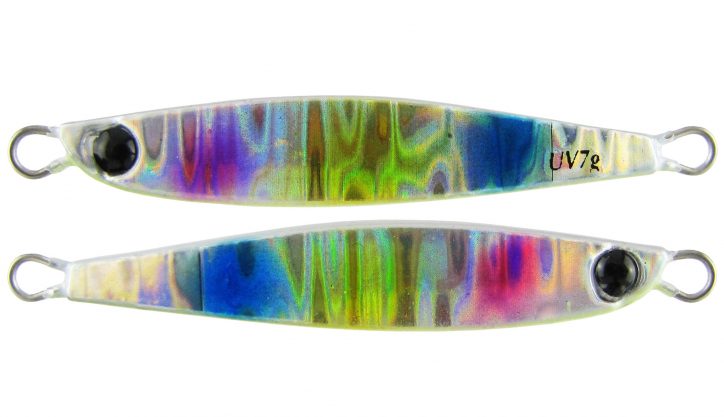
(RB “Breeze” jig. Photo by © Russkaya Blesna)
Only 6-gram Crystal jig and 9-gram Murena jig are produced in one weight. Breeze, Saipan, Reef, Katran, Magic, Salvador, Roxi and Expert models are produced in different sizes. New 2017 RB models (Murena and Breeze) have a film iridescent coating that meets the highest modern world standards. A wide choice of colors is presented. This enables you to choose the right lure for any lighting. The line has special light-saving colors for fishing at night. In addition, the body of Murena minnow has a complex textured surface imitating scales.

(RB “Murena” jig. Photo by © Russkaya Blesna)
In addition to jigs, the RB sea program includes Argo buler. The name “buler” became a common name for this type of lure long ago. The first product of this kind was produced by the Japanese Fujiwara Company.

(RB “Argo” buler with Marukyu Power Isome and goldblotch grouper. Photo © Shore Fishing Games)
The purpose of the lure is to keep the “floating” component in the water (mini-minnow, or mini-spoon bait) due to its shape. It shouldn’t be some kind of jig-head and attract fish at the same time. The oval shape of lures, which resemble wide skis a bit, and their weight (1.8, 3 and 5 grams) enable them to pass along the bottom without hooks, almost never falling into narrow cracks between the stones. Sea breams, rockfish and other inhabitants of the sea are caught with hooks with soft (“edible” at best) lures, such as marine worms produced by Marukyu and Berkley Companies, without much effort. It is confirmed by the huge number of anglers.
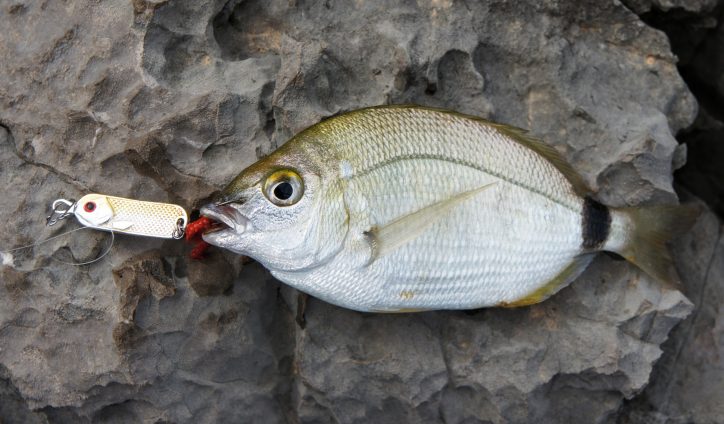
(RB “Argo” buler with Marukyu Power Isome and annular seabream. Photo by © Shore Fishing Games)
As any fisherman, I have my “favorite lure”. It is Matrix spoon bait. Fans that experiment a lot confirmed that the actions of the spoon bait were so good that it could catch almost any small predator, as well as relatively peaceful inhabitants of the sea, strolling in search of prey at depths of up to 8-12 meters.
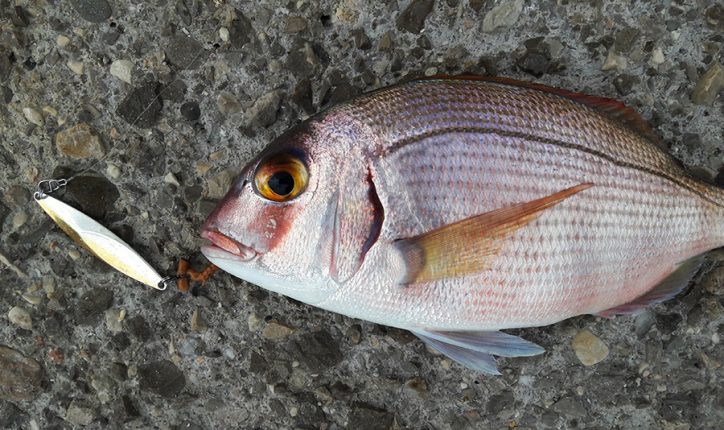
(RB “Matrix” spoon with Marukyu Power Isome and annular seabream. Photo by © adriaticnature)
The bite becomes even more active when you replace the triple hook with a single hook of S-59 model manufactured by Owner/C’ultiva Company with “edible” soft plastic marine worms and crabs produced by Japanese manufacturers. In this equipping variant, Matrix proved to be no worse than the Argo, while being heavier and, thus, having the ability to catch more fish within a vaster water area. Argo and Matrix complement each other perfectly.

(RB “Matrix” spoon with Marukyu Power Isome and Atlantic lizardfish. Photo by © adriaticnature)
Russkaya Blesna Company produces jig-heads of its own brand. They can be of a classic shape. It reduces the cost of the product with no loss in quality. There are unique ones as well. They are called RB Jighead F. Their geometry is modeled specifically in order to increase the “floating” qualities of the lure.

(RB Jighead “F”. Photo by © Russkaya Blesna)
These jig-heads are independent elements attracting fish that have their own game while following. They are made of brass, the specific weight of which is lower than the specific weight of conventional lead. This fact influences the floating effect in a good way. RB also produces jig-heads with a skull-shaped sinker as a souvenir product and for the fans of skull-aesthetics.
In addition to the sea program, in which the fishermen of the Adriatic and other seas are interested, Russkaya Blesna pays special attention to lures for catching salmonids, trout, in particular. Because of the decrease in the amount of fish near big cities, trout fishing in ponds has become popular recently. It is called “area fishing”, that is, fishing on paid water bodies stocked with fish.
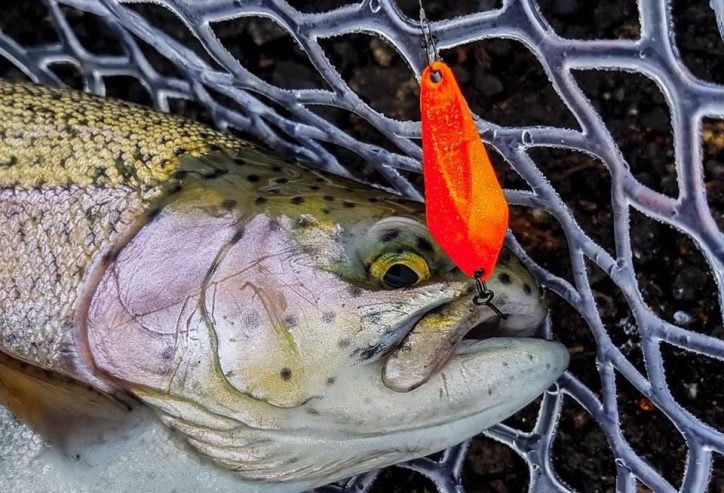
(RB “Fenix-new” spoon and rainbow trout. Photo by © Anton Arseniev)
There are about one hundred and fifty “paying” fishermen in Moscow suburbs solely. Working properties of RB trout spoon baits are self-explanatory. The Battle of Producers Competition has been held on the paid water bodies with trout since 2014. Each team, participating in the competition, uses lures of only “their” brand during fishing. Russkaya Blesna team won two annual competitions that were held.
And by the way, no matter how hard you try, you can’t explain what it has to attack the spoon bait, which is involved in the tournament, and it has to be caught very quickly.

(RB spoons, designed for “area fishing”. Photo by © Russkaya Blesna)
A joke springs to mind: a man comes to the doctor and asks: “Doctor, please, prepare me the results of the tests for a hundred euros instead of ten, and in five minutes instead of three days”, the doctor responds: “I’m sorry, microbes don’t take money”. The same situation is with trout – you can admire the beauty of the products, which have received the main prizes at foreign or domestic exhibitions, but only the fish can show interest in them by showing interest in what it really likes.
Therefore, the seal “checked up by fish” can be put on almost all of our lures.

(RB spoons, designed for catching wild trout. Photo by © Russkaya Blesna)
The use of RB trout lures is by no means limited to the zone of paid water bodies of city suburbs. Fishing on trout rivers is also in their wheelhouse. There is a video that captures catching brown trout with Russkaya Blesna spoons. “Wild” trout likes RB spoon baits just as much as the trout in ponds. And on the waters of the Balkan and the Apennine peninsulas, the “micro-blinkers” proved to be excellent when catching trout and char in the mountain lakes.
(Catching brown trout with RB spoons. Video by © Russkaya Blesna)
There are several more types of lures that the fans of sea fishing can be interested in.
The first one is devon lures produced by RB. Devons have existed for a long time, but our company was the first to make a major change in the design of this lure and, moreover, we patented this invention. The change was as follows: mounting of two high-quality bearings produced in Russia to ensure stable and smooth rotation of the “wings” of the lure, which now enables you to follow devon at various speeds, instead of only high-speed following. Originally designed to catch asp, devons are supposed to attract little tunny, dorado, bonito, and other pelagic fishes that hunt near the water surface. Structurally, they are completely ready for use in saltwater. You just have to wash devons with fresh water after fishing in the sea, in order to avoid drying of the salt inside the item, which will interfere with the proper operation of the bearings.
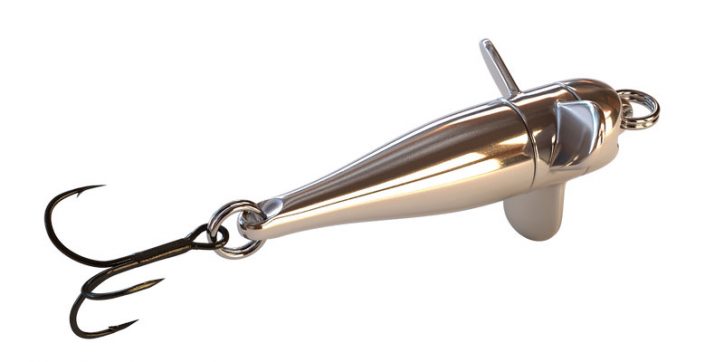
(RB “Meteorus” devon lure, sinking in front. Photo by © Russkaya Blesna)
The second type of lures, to which special attention must be paid, are lures for asp fishing. Triangle, Triangle of Sabunaev, Stiller (rhombus of Ishutin) and Delphi are in general compact in essence and have excellent floating features with the original games, which excellently attract predatory pelagic fish.

(RB lures for asp fishing. Photo by © Russkaya Blesna)
The third type of lure, which is produced by Russkaya Blesna is streamers. First of all, they are used with far-ranging spoon baits, devons and metal jigs mentioned above. The streamer is mounted on the leash above the artificial lure at the distance of up to 50 centimeters. A tandem of the streamer and the jig, spoon bait, devon is a more visible gear and it annoys fish a lot more. Often, a large predator is triggered by a natural instinct, and it tries to pick up the prey of a massively smaller predator, hunting in its zone. In this case, the predator perceives the jig as a competitor, the streamer is a potential victim here.
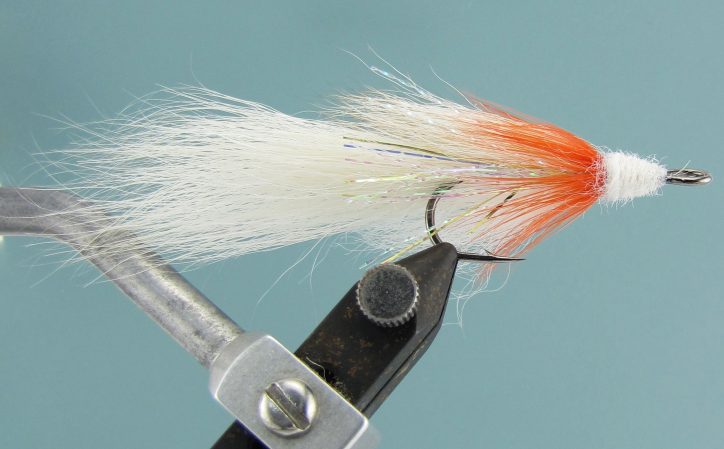
(RB streamer. Photo by © Russkaya Blesna)
Russkaya Blesna Compay produces many accessories for fishing, but I would like to focus on one of them. It would be very useful on the shores of the Adriatic Sea and freshwater water bodies of countries located on its shores. One must admit that Montenegrins, Croats, Italians and other residents of the region are smoking nations. Cigarette butts are the most common garbage. It takes about five years for the cigarette butt to decay. Indeed, no one wants to be at a beautiful pond, look down and feel like you’re at the station of a poor provincial village, spit at and covered with a layer of stubs.
RB has developed and manufactured a pocket ashtray. It has a removable screw cap, an aluminum strong casing, two hidden holes for cigarettes, with the ability to close and open it in any direction without a second thought. There is enough space for the compact ashtray in your pocket. It is equipped with an extending coiled cord (retriever), which adds a lot of mobility when using and insures it from loss. Using this accessory enables you to spend time in a civilized manner while enjoying your bad habit.
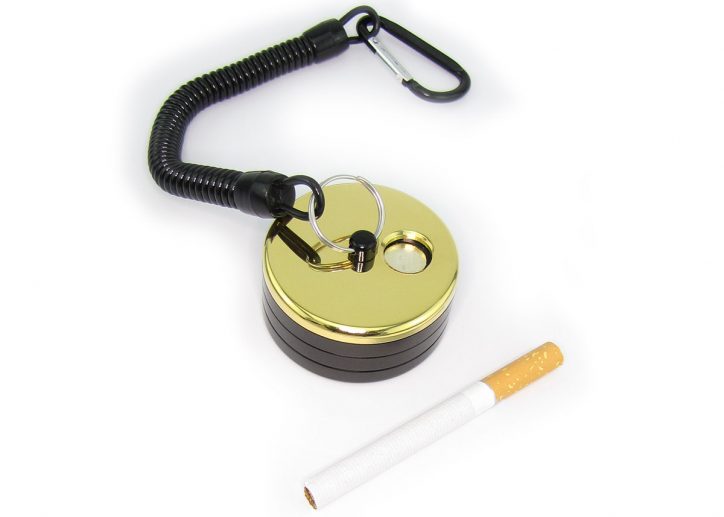
(RB Pocket Ashtray. Photo by © Russkaya Blesna)
Here are some facts from the history of producing spoon baits in the USSR. There is such an anecdote. Once upon a time, Nikita Khrushchev’s fellow fishermen complained that in the USSR people fly into space, actively build factories, and, eventually, corn will cover all the fields. But quality fishing lures are a damp squib. Khrushchev reckoned for a while, signaled to someone and soon, with the help of engineers’ efforts, a spoon bait Atom appeared. It was such a success and a so good for fishing that it has remained no less and maybe even more legendary than Kastmaster in the post-Soviet countries for the past 60 years. The range of RB products includes Atom spoon bait as well (the version sinking in the back). It produces low-frequency vibrations in water, which attract predatory fish. We are sure that if Khrushchev had an opportunity to check it out, he would postpone his important business and come to look at the company that has such a high-quality production of spoon baits that are excellent for fishing.
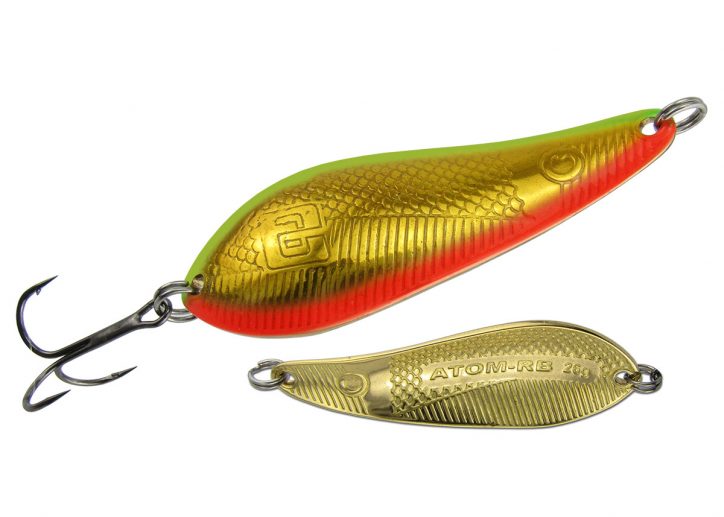
(RB “Atom”- spoon bait sinking in the back. Photo by © Russkaya Blesna)